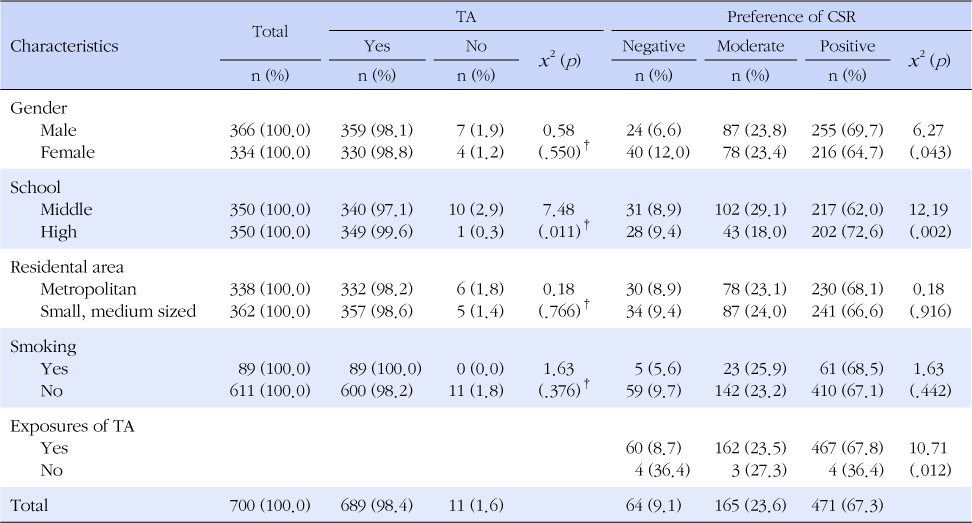References
1. Korea Center for Disease Control & Prevention. Statistics of online survey of adolescent health behavior 2012 [Internet] Seoul: Korea Center for Disease Control & Prevention; 2012. cited 2013 July 22. Available from:
http://yhs.cdc.go.kr.
3. Ministry of Health and Welfare. A study on the actual condition of the smoking in the second half of 2011 [Internet] Seoul: Ministry of Health and Welfare; 2011. cited 2013 July 22. Available from
http://www.kash.or.kr/user_new/pds_view.asp.
5. Li L, Borland R, Fong GT, Thrasher JF, Hammond D, Cummings KM. Impact of point-of-sale tobacco display bans: Findings from the international tobacco control four country survey. Health Educ Res 2013;28(5):898–910.
http://dx.doi.org/10.1093/her/cyt058.
9. Lee HH. National tobacco control programmes. Health Welf Policy Forum 2007;129:6–21.
10. Park SO. National policy for adolescent smoking prevention and cessation. Health and Welfare Policy Forum 2007;129:22–34.
14. Gilpin EA, White MM, Messer K, Pierce JP. Receptivity to tobacco advertising and promotions among young adolescents as a predictor of established smoking in young adulthood. Am J Public Health 2007;97(8):1489–1495.
15. Joe HO. The effects of cigarette companys image advertising on public cigarette consumption. Health Welf Policy Forum 2005;105:83–91.
16. Oh MY. Influence of smoking perception and attitude on the image of tobacco Company and the perception of its CSR activities. Speech Commun 2010;13:145–183.
17. Choi JM. The effect of on-screen smoking on adolescent smoking initiation - vicarious functional learning about smoking via the empathy toward the smoking character. Korean J Broadcasting 2009;23(2):526–566.
18. Tak JY. A study on the effects of magazine cigarette advertising on consumers' social behaviors. Advert Res 2002;57:195–222.
19. Shin SR, Jeong GC, Lee BK. The influence of cigarette advertising and susceptibility to smoking on adulthood smoking intention. Korean J Youth Stud 2012;19(10):1–22.
20. Faul F, Erdfelder E, Lang AG, Buchner A. G
*Power 3: A flexible statistical power analysis program for the social, behavioral, and biomedical sciences. Behav Res Methods 2007;39(2):175–191.
http://dx.doi.org/10.3758/BF03193146.
21. Kim BC, Lee CH. A study of tobacco company's corporate social responsibility effects. Korean J Advert Public Relat 2011;139(4):5–37.
22. Sussman S, Miyano J, Rohrbach LA, Dent CW, Sun P. Six-month and one-year effects of project EX-4: A classroom-based smoking prevention and cessation intervention program. Addict Behav 2007;32(12):3005–3014.
http://dx.doi.org/10.1016/j.addbeh.2007.06.016.
23. Lovato C, Linn G, Stead LF, Best A. Impact of tobacco advertising and promotion on increasing adolescent smoking behaviours. Cochrane Database Syst Rev 2003;(4):CD003439.
http://dx.doi.org/10.1002/14651858.CD003439.
24. Perez DA, Grunseit AC, Rissel C, Kite J, Cotter T, Dunlop S, et al. Tobacco promotion 'below-the-line': Exposure among adolescents and young adults in NSW, Australia. BMC Public Health 2012;12:429.
http://dx.doi.org/10.1186/1471-2458-12-429.
25. Kim YH, Hoe MS. Examination of the effectiveness of an adolescent smoking prevention program criticizing cigarette advertisements. J Sch Soc Work 2011;21:267–296.
26. Sargent JD, Dalton M, Beach M, Bernhardt A, Heatherton T, Stevens M. Effect of cigarette promotions on smoking uptake among adolescents. Prev Med 2000;30(4):320–327.
27. Arora M, Stigler MH, Reddy K. Effectiveness of health promotion in preventing tobacco use among adolescents in India: Research evidence informs the national tobacco control programme in India. Glob Health Promot 2011;18(1):9–12.
http://dx.doi.org/10.1177/1757975910393163.



